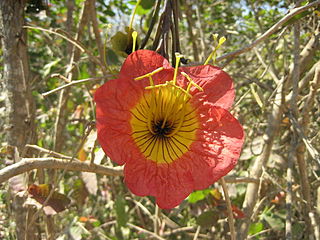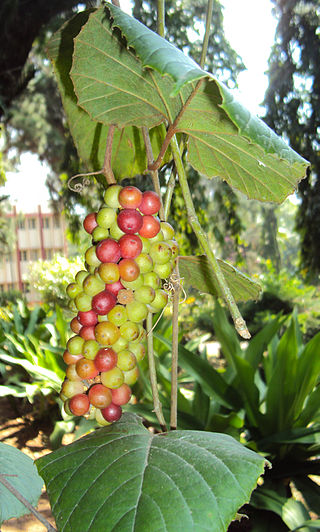
Gentiana is a genus of flowering plants belonging to the gentian family (Gentianaceae), the tribe Gentianeae, and the monophyletic subtribe Gentianinae. With over 300 species, it is considered a large genus. Gentians are notable for their mostly large trumpet-shaped flowers, which are often of an intense blue hue.

Gentianaceae is a family of flowering plants of 103 genera and about 1600 species.

Adenolisianthus is a plant genus in the gentian family (Gentianaceae), tribe Helieae. The name of the genus is derived from Greek roots meaning "gland-bearing and smooth flower". Only one species, Adenolisianthus arboreus, has been classified as part of this genus. It was first recognized as a separate genus in H.G.A.Engler & K.A.E.Prantl, Nat. Pflanzenfam. 4(2): 98 (1895). Until then, the species was treated as part of the genus Lisianthius.

Ochna is a genus comprising 79 species of evergreen trees, shrubs and shrublets belonging to the flowering plant family Ochnaceae. These species are native to tropical woodlands of Africa, Madagascar, the Mascarenes and Asia. Species of this genus are usually called ochnas, bird's-eye bushes or Mickey-mouse plants, a name derived from the shape of the drupelet fruit. The name of this genus comes from the Greek word ὄχνη (ókhnē), used by Theocritus and meaning "wild pear", as the leaves are similar in appearance. Some species, including Ochna integerrima and O. serrulata, are cultivated as decorative plants.

The genus Macrocarpaea, with 105 species and two hybrids of 0.5 m herbs, shrubs, epiphytes and small trees to 10 m tall, is the largest genus of the tribe Helieae of the gentian family (Gentianaceae). Species of Macrocarpaea have diurnal and nocturnal pollinators, visited during the day by hummingbirds, insects and butterflies, and at night by bats, moths and many different kinds of insects. The common name for the genus is 'Moon-gentian'. No species are known in cultivation.

Cleome is a genus of flowering plants in the family Cleomaceae, commonly known as spider flowers, spider plants, spider weeds, or bee plants. Previously, it had been placed in the family Capparaceae, until DNA studies found the Cleomaceae genera to be more closely related to the Brassicaceae than the Capparaceae. Cleome and clammyweed can sometimes be confused.

Campylospermum is a genus of flowering plants in the family Ochnaceae. It includes 55 species native to tropical Africa, India, Indochina, Hainan, and western Malesia.

Fagraea is a genus of plants in the family Gentianaceae. It includes trees, shrubs, lianas, and epiphytes. They can be found in forests, swamps, and other habitat in Asia, Australia, and the Pacific Islands, with the center of diversity in Malesia.

Fernandoa is a genus of plants in the family Bignoniaceae; species are found in tropical Africa, India and south-east Asia.

Ampelocissus is a genus of Vitaceae having 90 or more species found variously in tropical Africa, Asia, Central America, and Oceania. The type species, A. latifolia, was originally treated under its basionym, Vitis latifolia, and was collected from the Indian subcontinent.
Dissotis is a genus of plants in the family Melastomataceae. It includes nine species of annual or perennial herbs, shrubs, or small trees which are native to tropical Africa.
Faroa is a genus of flowering plants in the gentian family (Gentianaceae), native to tropical Africa. Faroa species are noted for their ability to grow in harsh conditions such as on bare rock, sand, mineralized soils, and mine tailings with high concentrations of copper.
Aporrhiza is a genus of flowering plants belonging to the family Sapindaceae.

Caloncoba is a genus of flowering plants belonging to the family Achariaceae.

Chytranthus is a genus of flowering plants belonging to the family Sapindaceae. It includes 32 species of small trees and shrubs native to tropical Africa, ranging from Guinea eastwards to Kenya and Tanzania and south to Angola. Most species have a palm-like habit, with large pinnate leaves and unbranched trunks.
Cnestis is a genus of flowering plants belonging to the family Connaraceae.
Deinbollia is a genus of flowering plants belonging to the family Sapindaceae.
Eriocoelum is a genus of flowering plants belonging to the family Sapindaceae.












